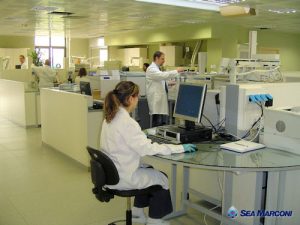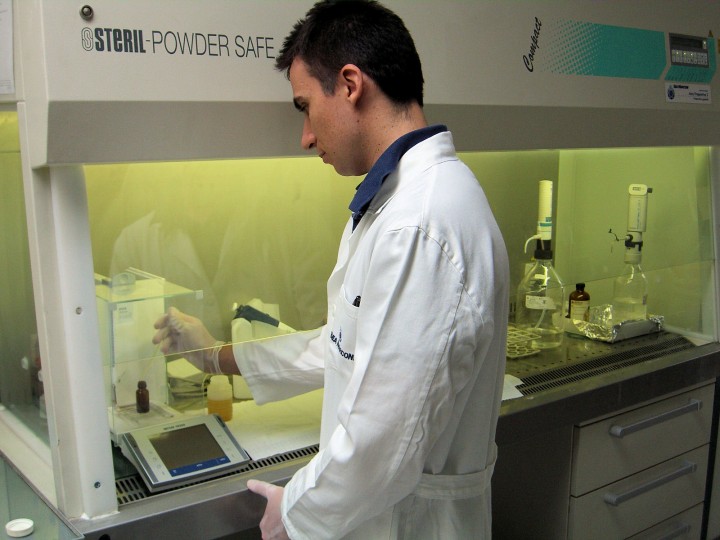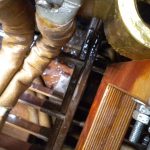
Sea Marconi has developed the Deosvision service for analysis and diagnosis, which is aimed at preventing the catastrophical failure of electrical equipment linked to critical issues,
In fact, it is very similar to what happens in clinical diagnostics, as one can monitor the health status of the transformer by analyzing a sample of oil taken from it and then make the subsequent diagnosis.
Deosvision involves the following steps:
- Sending the client a kit to sample the fluid
- Extracting the sample from the transformer and sending it to the Sea Marconi laboratory
- Completeing the required laboratory analysis
- Issuing the diagnostic report, which clearly highlights both the problems identified, and the course of action to take.
What analysis is there to do on the different transformers? How often is it necessary to repeat the analysis? How can one be sure that the transformer does not have, for example critical corrosion issues or gas dissolved in the oil?
Diagnostic packages
Based on the investigation’s aim Sea Marconi can suggest a specific diagnostic package (with a series of targeted analysis), for example to know the state of health of a transformer at a specific point in its life cycle (LCM) or to identify/expand on a particular critical “disease” that the oil or transformer has.
Below are the main packages:
- Factory Test Pack
- Fluid Pack
- Intermediate Pack
- Extended Pack
- Thermal Life Pack
- Corrosive Pack
- Pack PCB
Factory Test Pack
Objective: evaluation of the occurrence of thermal or electrical faults during factory tests (heat or other tests).
Application: applied to all insulating liquids.
Tests include:
Dissolved Gas: (DGA) (IEC 60567) A
Diagnostic interpretation: This package does not include diagnostic assessments, which are delegated to the manufacturer or in general to the client requiring the test.
A Test accredited by Accredia
Note:
The measured value of dissolved gas depends on the nature and duration of the test run, and it is usually agreed between the equipment supplier and the purchaser.
Fluid Pack
Objective: Evaluation of the oil’s functional deterioration, and its main dielectric properties
Application: applied to all insulating liquids.
Tests include:
Appearance (visual)
Colour (ASTM D 1500 or ISO 2211)
Dissolved Water (IEC 60814) A
Dielectric Dissipation Factor – DDF – Delta tangent (IEC 60247)
Relative permittivity – Relative dielectric factor (IEC 60247)
Neutralization number – TAN (1) (IEC 62021-1)
Particles in suspension, number and dimension >4, >6, >14 µm (IEC 60970)
Hydrocarbons in the askarel (2) (CEI 10-6)
Diagnostic Interpretation: Included
A An ACCREDIA accredited test
Note:
(1) do not apply to chlorinated insulating liquids (Askarels)
(2) Apply only to chlorinated synthetic insulating liquids (Askarel)
Intermediate Pack
Objective: Targeted evaluation of some of the oil’s and transformer’s functional deterioration factors:
– Functional deterioration of the insulating liquid by a reduction in its main dielectric properties and the possible presence of physical contaminants;
– Functional deterioration of the transformer by dissolved gas analysis (DGA), to identify and classify the presence of any incipient functional defects in the machine, before they develop into failures and interruptions in service: electrical anomalies (high or low energy discharges , partial discharges, corona effect), thermal anomalies (thermal oxidation, hot spots), solid insulation deterioration.
Application: applied to all insulating liquids
Tests include:
Appearance (visual)
Colour (ASTM D 1500 or ISO 2211)
Dissolved Water (IEC 60814) A
Dielectric Dissipation Factor – DDF – Delta tangent (IEC 60247)
Relative permittivity – Relative dielectric factor (IEC 60247)
Neutralization number – TAN (1) (IEC 62021-1)
Particles in suspension, number and dimension >4, >6, >14 µm (IEC 60970)
Hydrocarbons in the askarel (2) (CEI 10-6)
Dissolved Gas (DGA) (IEC 60567) A
Diagnostic Interpretation: Included
A An ACCREDIA accredited test
Note:
(1) do not apply to chlorinated insulating liquids (Askarels)
(2) Apply only to chlorinated synthetic insulating liquids (Askarel)
Extended Pack
Objective:
– The insulating liquid’s state of functional deterioration;
– the machine’s state of functional deterioration (any thermal or electrical faults);
– the state of corrosion or erosion, by dissolved metal and element analysis as well as external contamination factors (calcium, silicon, potassium), the quality of the refining and desulphurisation of petrol (total sulphur);
– the state of deterioration for solid insulation, through 2-furfuraldehyde and furan compounds analysis, related to the concentration and rate of water, CO2 and CO formation.
Application: applied to all insulating liquids.
Tests include:
Appearance (visual)
Colour (ASTM D 1500 or ISO 2211)
Dissolved Water (IEC 60814) A
Dielectric Dissipation Factor – DDF – Delta tangent (IEC 60247)
Relative permittivity – Relative dielectric factor (IEC 60247)
Neutralization number – TAN (1) (IEC 62021-1)
Particles in suspension, number and dimension >4, >6, >14 µm (IEC 60970)
Hydrocarbons in the askarel (2) (CEI 10-6)
Dissolved Gas (DGA) (IEC 60567) A
Dissolved Metals (ASTM D 7151)
2 – Furfural and furan compound derivatives (IEC 61198) A
Diagnostic Interpretation: Included
A An ACCREDIA accredited test
Note:
(1) do not apply to chlorinated insulating liquids (Askarels)
(2) Apply only to chlorinated synthetic insulating liquids (Askarel)
Thermal Life Pack
Objective: Targeted evaluation of the critical factors related to the state and rate of thermal decay in solid insulating materials (Kraft paper), by means of analysing and studying the trend in the card’s main thermal degradation markers.
PThis provides an annual or biennial monitoring plan, completing a minimum program of four samples taken on a regular basis (quarterly or biannually) to identify the card’s state and relative rate of decay, compared to the same types of transformers and equipment in typical conditions.
Application: applied to all insulating liquids.
Tests include:
Dissolved Water (IEC 60814) A
Dissolved Gas –DGA ( IEC 60567) A
2 – Furfural and furan compound derivatives (IEC 61198) A
At the end of the monitoring plan the Kraft card’s state of thermal decay is evaluated as well as the related life consumption, and where possible, an estimate of the equivalent DP range based on different algorithms and interpretative models.
Diagnostic Interpretation: Included
A An ACCREDIA accredited test
Corrosive Pack
DEOS CORROSIVE BASE
Application: Applied only to mineral insulating oils.
Tests included:
Potentially Corrosive Sulphur – CCD teston conductors wrapped in paper (IEC 62535) (IEC 62535)
TTAA (Toluil-triazolammina) – Irgamet®39 (IEC 60666)
Diagnostic interpretation: The package includes a general comment on the corrosive conditions of the oil as highlighted by the test results..
DEOS CORROSIVE COMPOUND
Application: Applied only to mineral insulating oils.
Tests include:
DBDS – dibenzyl sulphide (SMT internal method – GC/AED)
Total Mercaptans and disulphides (SMT internal method – potentiometric titration)
Diagnostic interpretation: the package includes a general comment on the corrosive conditions of the oil highlighted by the test results.
DEOS CORROSIVE SCREENING
– the formation of copper sulphate on bare copper conductors
– the formation of copper sulphate deposits on Kraft paper in the reels
– the presence of additives that can alter or mask the intrinsic reactivity of the oil.
Application: Applied only to mineral insulating oils..
Tests include:
Corrosive Sulphur on copper specimens (ASTM D 1275 B)
Potentially Corrosive Sulphur – CCD test, on conductors wrapped in paper (IEC 62535)
DBDS – dibenzyl sulphide (SMT internal method – GC/AED)
Passivating triazole additives – BTA + TTAA (IEC 60666)
Phenolic antioxidant additives – DBPC + DBP (IEC 60666)
Diagnostic interpretation: the package includes a general comment on the corrosive conditions of the oil highlighted by the test results.
DEOS CORROSIVE DELUXE
– the formation of copper sulphate on bare copper conductors, qualitative and quantitative evaluation
– the formation of copper sulphate deposits on Kraft paper in the windings
– the presence of additives which may alter or mask the intrinsic reactivity of the oil
– evaluation of DBDS decomposition by-products.
BDS.
Application: Applied only to mineral insulating oils.
Tests include:
Potentially Corrosive Sulphur – CCD test, on conductors wrapped in paper (IEC 62535)
DBDS – dibenzyl sulphide (SMT internal method – GC/AED)
Passivating triazole additives – BTA + TTAA (IEC 60666)
Phenolic antioxidant additives – DBPC + DBP (IEC 60666)
BBZ – Bibenzyl (test method: SMT internal GC/MS)
TCS – Total Corrosive Sulphur (SMT internal method)
Diagnostic interpretation: the package includes a general comment on the corrosive conditions of the oil highlighted by the test results.
Pack PCB
Objective: Targeted evaluation of PCB/PCT/PCBT in insulating liquids and petroleum products, both new and used, in accordance with Directive 59/96/EC (Article 2) dated 16/09/1996, following the state-of-the-art (BAT).
Application: Applicable to all insulating liquids.
Included Tests:
Polychlorinated Biphenyls (PCB) in accordance with IEC EN 61619:1997 A
Polychlorinated Terphenyls (PCT) and Polychlorobenzyltoluenes (PCBT) in accordance with EN 12766:2005 (Part 3). A
This includes the recognition of the commercial mixture constituting oil contamination (e.g., Aroclor mixtures for PCB, Ugilec mixtures for PCBT).
If the measurements reveal that the examined sample consists of pure PCB (Askarel), PCB quantification will not be performed, and evidence will be provided through FT-IR spectrum analysis in the infrared range.
Diagnostic Interpretation: Includes opinions and interpretations regarding compliance with current Directives and Laws.
A tests accredited by ACCREDIA.
What makes our service so effective?
Firstly, the Sea Marconi laboratory is an international leader in insulating fluid and electrical equipment deterioration diagnostics: powerful and scaled transformers, reactors, rectifiers, drives and loops.Furthermore we are known for the following key points:
Complying fully with industry standards
The certification of our tests
Profound subject knowledge
Nonstop research and development
The development of an unparalleled diagnostic tool
The largest data bank in the private sector
In an emergency, the Sea Marconi laboratory provides an analytical response in just 4 working hours
The dielectric fluid industry is becoming ever more sophisticated.Imagine that just among the category of new mineral oils one can now count more than 30 different oils (See.IEC 60296), then there are natural or synthetic esters that further complicate the task of identifying the state of deterioration.As for less common oils there is not a great number of case studies and often there is not even a reference standard.
Sea Marconi can boasts plenty of experience even with “niche”oils. With natural esters for example, which currently are preferred from an environmental aspect due to their biodegradability and fire risk, not only when doing diagnostics it is necessary to adopt very different interpretive criteria compared to mineral oils, but also during the treatment phase, when totally different considerations need to be taken in to account.




















